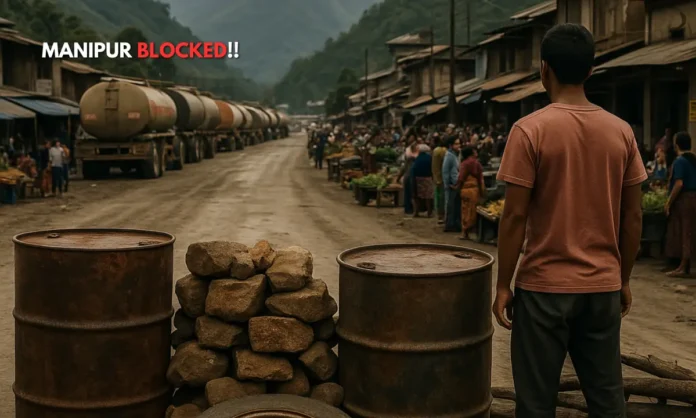Summary
- Disrupted access to NH-2 and NH-37 has led to severe supply shortages in Manipur, especially in Churachandpur and Imphal.
- Goods rerouted through Mizoram have caused massive transportation delays, fuelling inflation and scarcity of medicines.
- Locals call for reconciliation, urging peace between ethnic groups as daily life grows increasingly unsustainable.
A State Strangled by Roads: How Manipur’s Lifelines Became Its Economic Traps
A year after ethnic clashes broke out in Manipur on May 3, 2023, the state remains mired in a humanitarian crisis that goes beyond violence: it now grapples with a chronic supply chain breakdown, punishing residents across tribal lines with skyrocketing prices, medicine shortages, and economic paralysis.
In Churachandpur, the Kuki-majority district worst affected by transport disruptions, essential goods like food, fuel, and medical supplies have become prohibitively expensive. The reason? Blockades along National Highways 2 and 37, the arterial routes that once connected the state to Assam and Nagaland.
Now, with these critical highways unsafe or entirely impassable, trucks are being rerouted through Mizoram, adding hundreds of kilometers to each journey—and thousands of rupees to every shipment. For locals, this means daily life is now governed by scarcity and inflation.
#WATCH | Highway blockades trigger soaring prices and shortages in Manipur; locals hope for normalcy#Manipur #Churachandpur #Imphal #floods #NorthEastIndia #ManipurViolence #HighwayBlockade #InflationCrisis #MedicineShortage #FloodRelief #EthnicTensions #NH02 #NH37… pic.twitter.com/lVRJeXsUFf
— ANI (@ANI) June 9, 2025
Churachandpur in Crisis: Rerouted Supplies and Vanishing Essentials
- Highways NH-2 and NH-37 remain largely non-operational between warring regions.
- Supplies diverted through Mizoram have tripled delivery times and costs.
- Medicine shortages have hit patients with chronic illnesses hardest.
- Traders are reluctant to use Imphal routes even under escort due to ongoing tensions.
- Price inflation is not artificial, say local consumer groups—it’s the cost of conflict.
In Churachandpur, what used to be a two-day truck journey now takes over a week. “Everything has become more expensive,” says Mang, a resident. But the crisis isn’t just about money. It’s also about health: hospitals and pharmacies are unable to stock drugs for heart disease, diabetes, and mental health conditions.
“People with serious diseases are struggling. We have no regular supply,” confirms Max Muan, former secretary of the Pharmacy Owners Association in Churachandpur.
Even consumer rights groups like the Lamka Consumers Club are urging outsiders to understand that this inflation is not opportunistic. “This price hike is not engineered by traders. It’s because everything must now come through distant, unsafe, and costly routes,” explains secretary Letminlal.
Imphal’s Parallel Struggle: Floods Compound Conflict-Driven Inflation
- Imphal’s access to goods remains tenuous amid ethnic segregation of supply routes.
- Recent floods in Nongmeibung have worsened food inflation and local hardship.
- Vendors face shrinking margins and growing losses as supplies dwindle.
- Local businesses suffer due to slowed delivery and customer drop-off.
- Citizens report a sense of “isolation” and growing mistrust between communities.
The state capital Imphal isn’t faring much better. While still partially accessible, routes in and out of the Meitei-majority city remain contentious, under heavy security surveillance, and increasingly unreliable. “We’re going through a lot of hardship,” says flood-hit resident Wangkheirakpam Saratchandra Singh. “There was already inflation here, and now the floods have made everything worse.”
Vendors like H Binodini Devi say they’re caught between escalating wholesale prices and shrinking consumer demand, especially for perishable goods. “The National Highway closures mean losses keep piling up,” she adds.
The combination of geopolitical segregation, natural disasters, and transport failure has isolated Manipur’s urban centres from one another—economically, socially, and emotionally.
A Call for Reconnection: Can Peace Reopen Manipur’s Lifelines?
What unites both sides of this fractured state is a common suffering—one rooted not just in violence, but in the collapse of economic coexistence. Without reliable transport between the Meitei and Kuki-majority regions, no part of Manipur can hope to function sustainably.
Locals in both Churachandpur and Imphal now say peace is not a luxury—it is a necessity. “We must reconcile,” say members of civil society in Lamka and Nongmeibung alike. “This economic pain affects all of us, not just one group.”
But reconciliation requires more than words. It demands reopening roads, restoring trust, and rethinking governance in a region where identity politics have overridden infrastructure and public health. Until then, Manipur remains not just divided, but starved.


